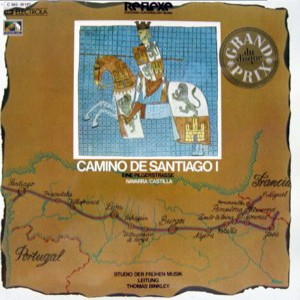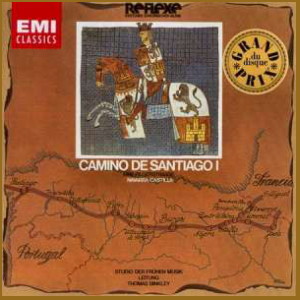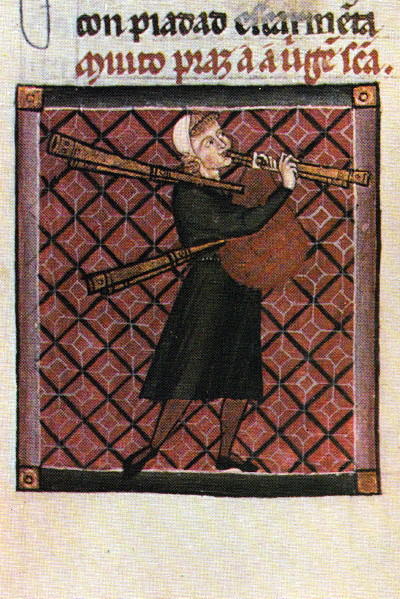 |
1 LP -
1C 063-30 107 - (p) 1973
|

|
| 1 CD - 8
26474 2 - (c) 2000 |
|
CAMINO
DE SANTIAGO I - Eine Pilgerstraße
Navarra-Castilla
|
|
|
|
|
|
| NAVARRA |
|
|
1. Quen a Virgen
(Cantiga 103) - Sängerin,
Chitarra Saracenica, Vielle
(Fiedel), Schlagzeug
|
8' 49" |
|
2. Seigneurs
(Teobaldo) - Sänger, Vielle
(Fiedel), Laute, Harfe
|
7' 02" |
|
3. Con gaudenat
(Conductus) - Vokalensemble
|
4' 32" |
|
|
|
|
| CASTILLA |
|
|
| 4. Plange
Castilla (Planctus) - Sängerin und
Symphonia (Drehleier) |
3' 18" |
|
5. Non e gran
causa (Cantiga 26) - Vokalensemble,
Laute, Vielle (Fiedel), Lira,
Organetto
|
11' 11" |
|
6. Quis dabit
(Planctus) - Sängerin, Laute
|
3' 01" |
|
|
|
|
STUDIO DER FRÜHEN
MUSIK / Thomas Binkley, Leitung
|
|
| -
Andrea von Ramm, Sängerin
(1,3,4,5,6), Organetto (5) |
|
| -
Richard Levitt, Sänger (2,3,5) |
|
| -
Sterling Jones, Streichinstrumente |
|
| -
Thomas Binkley, Zupfinstrumente,
Symphonia (Drehleier) |
|
|
|
|
|
Luogo
e data di registrazione |
|
Bürgerbräu.
München (Germania) - 1972
|
|
|
Registrazione: live /
studio |
|
studio |
|
|
Producer / Engineer |
|
Gerd
Berg / Wolfgang Gülich
|
|
|
Prima Edizione LP |
|
EMI
Electrola "Reflexe" - 1C 063-30
107 - (1 lp) - durata 37' 53" -
(p) 1973 - Analogico |
|
|
Prima Edizione CD |
|
EMI
"Classics" - 8 26474 2 - (1 cd) -
durata 37' 53" - (c) 2000 - ADD |
|
|
Note |
|
- |
|
|
|
|
|
 Medieval
Music along
the Prigrim Route of Saint
James, 13th Century Medieval
Music along
the Prigrim Route of Saint
James, 13th Century
The story began in Jaffa,
today an Arab town just
outside of Tel Aviv, where in
the first century Jacob war
born, brother of John and son
of Zebedeo and Maria
Salomé,
who was the sister of Mary,
mother of
Jesus. This direct connection
to the Holy Family lends
importance to the place
containing the remains of the
evangelist St. James.
James - Jacob - Iago - Saint
Iago - Santiago went to Spain
to preach and returned
eventually to Jerusalem, where
he was decapitated by Herodes
Agrippa some ten or twelve
years after the death of
Jesus. His remains were
brought back to Spain, to rest
in the palace of a wealthy
follower. Centuries passed,
armies came and went, and then
in the ninth century with the
aid of a miraculous light, a
hermit rediscovered the
sepulchre. Today this place
is called Santiago de
Compostela, St. James in the
Field of Stars. Thus it was
that Santiago de Compostela
joined Jerusalem (Holy
Sepulchre) and Rome (St.
Peters) as one of the focal
points of Christian
pilgrimage.
The Camino, the road leading o
Santiago is really a complex
of many roads coming from
different places, the Camino
del Mar, the Camino
Portugués,
the Camino de Cataluña
etc. It
was however the Camino
Francés which was the
most important for it was the
most international. Pilgrims
from all over Europe walked
and rode over its many byways
for centuries.
At reasonable distances along
the route were hostles where
the pilgrims might stop over,
these frequently being
operated by monasteries.
Pilgrims enjoyed a
considerable civil protection
under the law, and were
entitled to free food and
lodging as well as to
information about the roads
and bridges and the location
of potable water between
hostles. In
some places this is still true
today for bona fide pilgrims.
Of all the adventures that
happened along the Camino, the
religious adventures take
precedence. The miracles of
Our Lady are to some extent
recorded in the Cantigas of
Alfonso X El Sabio, the
Cantigas de Santa Maria,
one of our main sources here.
Not all of the music along the
Camino told of miracles -there
are hymns and exaltations as
well.
This then is what these
recordings are about. The
songs tell about specific
happenings along the Camino,
and for the most part, the
places where they happened are
still there and can be
visited. So we make our own
pilgrimage in sound along the
Camino Francés,
through Navarra, Castile, León and
ending in Galicia, the
province of Santiago de
Compostela.
What is the music? It is
the meeting of the way between
folk music of the past and
profound poetry. It is a
natural music, built on text
and melody and improvisation,
the really human elements of
the musical art. It has also a
touch of the speculative or
cogitative qualities that
catch the mind and bind the
listener.
Christian and Moorish elements
join together, poems in the
form of the Arabic zejel
performed with a Moorish
orchestra, Latin conducti in
the Roman tradition... but
music can seldom be described
it must
be heard. Here is a coileotion
of surprising scope,
encompassing some of the most
grandiose music of the Middle Ages
and some of the most intimate.
NAVARRA
Quen a Virgen Cantiga
103
Two forks of the Camino Francés meet
inside Spain at Puente la
Reina. One passes from San
Miguel through Viscarret and
leads on through Pamplona,
while the other, coming from
Arles, crosses at Berce, and
leads on through Jaca and Monreal.
Between Jaca and Puente la
Reina, more precisely between
Sangüesa
and Yesa just inside the
province of Navarra, a road
leads north to the monastery
of San Salvador de Leyre. Here
in the 10th century was an
abbot, San Virila, who is said
to have never known boredom,
and thus was he able to pass
300 years listening to the
song of a bird, as told in
this contiga. The man, a
historic personage who was
born in Tiermas, nearby, just
over the border into the
province of Zaragosa, was
active at the monastery of
Samos, which is between
Santiago de Compostela and León,
near Triacastela. His remains
were interred in Leyre, to be
moved later to the cathedral
at Pamplona.
Seigneurs, sachiez qui or
ne s’en ira Teobaldo,
Rey de Navarra
Not far from Puente la Reina
along the Camino Francés is
the town of Estrella, today a
delight in its unpretensious
traditional atmosphere coupled
with its historic monuments
and very excellent cuisine.
Much of what is there today
was well known to Teobaldo,
who further north is known as
Thibaut, comte de Champaigne
(1201-1253), and who was one
of the most prolific
troubadours. He was
French-speaking, and his
occasional presence there must
have been some encouragement
to the French pilgrims, who
stopped there to enjoy that
which was described in the 12th
century tourist guide-book,
Codex Calixtinus, as
"such good bread, excellent
wine and abundant meat and
fish, and full of every
happiness."
Con gaudeant catholici
Conductus
Of the many Latin songs
connected to the Camino de
Santiago, this is today the
best known. As is the case
with many pieces in this
genre, it was probably a
simple Latin song
originally, then it was made
into a two-voice conductus
and here we have it in its
final form as a three part
piece. As such, it is well
known as the earliest
three-voice composition...,
it is taken from the Codex
Calixtinus, where it bears
the attribution to Magister
Albertus Parisiensis.
CASTILLA
Plange Castilla Planctus
Countries change. The
Kingdom of Castile is now
called Old Castile in
difference to the modern
province surrounding Madrid.
Fernando I,
son of Sancho of Navarra,
called el Mayor, King of the
Spains, ascended the throne
in Burgos in 1035. This
capital and residerics
rapidly became an important
city in medieval Europe.
Roland, Orlando, El Cid
Campeador made the city
famous for us, but for the
pilgrims along the Camino de
Santiago, Burgos was the
most prominent resting place
some 420 km from Santiago as
the crow flies, with a
multitude of hostles and
with special laws governing
the gates to the city and
other matters regarding the
travellers. Sancho II
(reg. 1065-1072) reunited
Castile with the kingdoms of
León
and Galicia, and Alfonso VI
(1072-1109) continued. Alfonso's daughter
Urraca was married to
Raymond of Burgundy, who,
the chronicles tell us, beat
his wife in public. She
withdrew to Galicia, and
made war on her husband
and saw her son recognized
in Galicia as king, even
during her lifetime. This
son, Alfonso VII
(reg. 1120-1157), called
Emperor of Spain, to enable
him to have Moorish royalty
among his vassals, had two
sons; on his death he left
Castile to his eldest and
Leon to his second son.
Sancho III
was the eldest son (reg.
1157-1158), whose rule was
but a single year. This is
the man, the king, whose
passing is lamented in the
planctus. His brother
Fernando II
and his son Alfonso VIII
are mourned in “Quis dabit"
and “sol eclysim”.
Non e gran causa Cantiga
26
The cleric Gonzalo de
Berceo, active 1230-1255 in San Millán
(Rioja), was a writer
who some feet tried to make
of popular literature
something elevated and
erudite. He was fascinated
by the musicians, the juglares,
and it is clear that he
pointed his work at the same
illiterate audience. It is
interesting to find among
the works of this prolific
popular poet an account of
the Roman who went to
Santiago, the same story
told in this Cantiga.
Quis dabit Planctus
Alfonso VIII
(reg. 1158-1214) brought a
generation of culture and
learning to Burgos, for
which he was called El
Noble. His other appellage,
El de las Navas, refers lo
his success in war,
specifically his victory in
1212 at Las Navas de Toloso,
over the Almohades,
the turning point of
Christian influence in
Moslem Spain. He married
Eleanor, sister of Richard
the Lionhearted, daughter
of Henry II
of England, himself
husband of Eleonor of
Aquitaine, daughter of the
first troubadour. He
fetched his bride in 1170
in the company of thirty
known troubadours, and he
had among his own
musicians Arabs,
Christians and Jews. Their
court was a meeting place
of these three Spanish
cultures, and its elegance
was praised by the
troubadour Peire Vidal.
Among his many services
rendered to Castile, the
founding of the monastery
Las Huelgas is of
particular significance
for us today, because it
is still there, still a
monastery, one of the very
few that remained in
essentially unbroken
operation since its
founding. This monastery
owns a manuscript
containing the musical
repertory of the
institution during our
period. Towards the end of
the manuscript, a few
laments are to be found on
the death of some Spanish
kings as well as an
abbess. It
seems to us likely that
Alfonso VIII
is the intended subject of
this lament or planctus.
Thomas
Binkley
|
|
|
EMI Electrola
"Reflexe"
|
|
|
|

